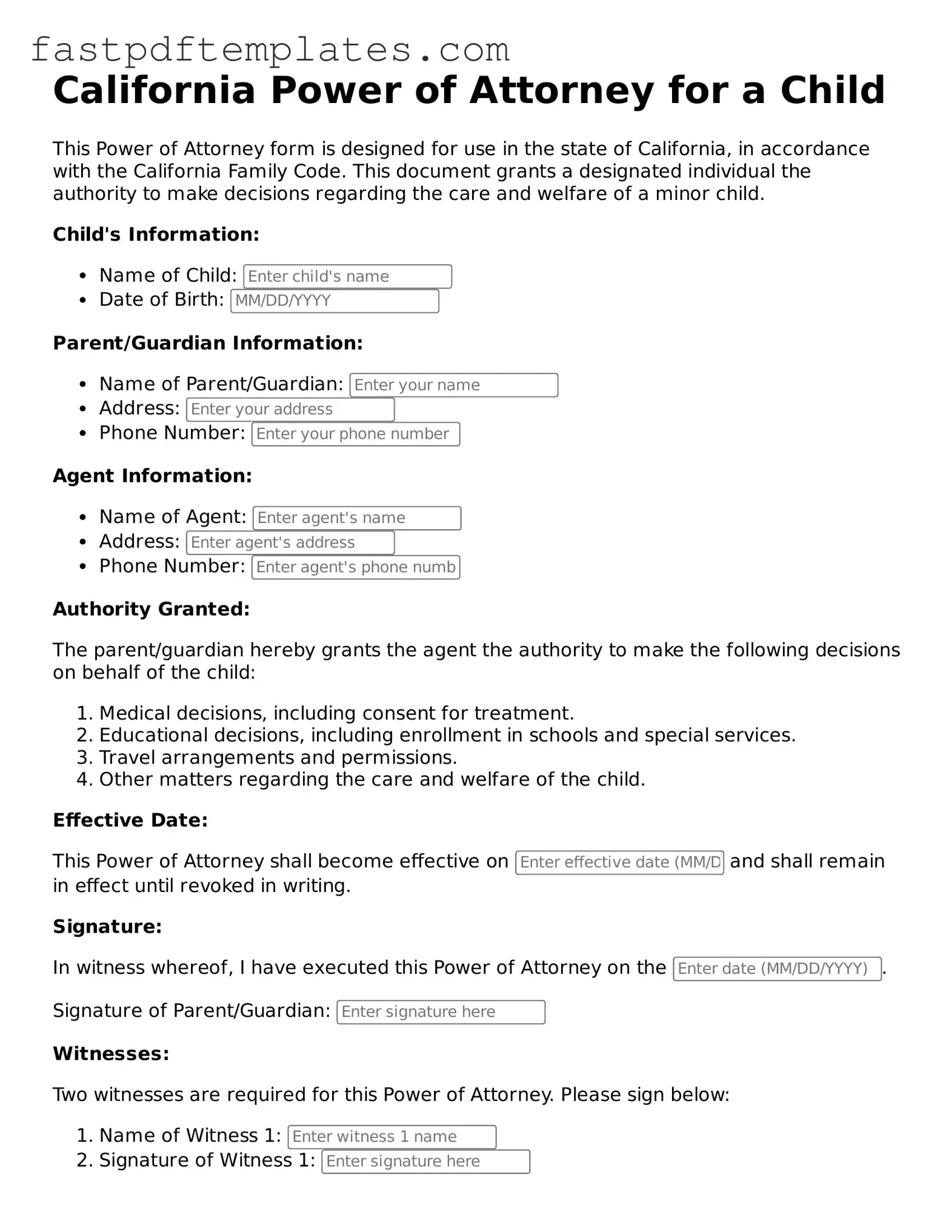The California Power of Attorney for a Child form is similar to a General Power of Attorney. Both documents allow an individual to appoint someone else to act on their behalf. In the case of a General Power of Attorney, this authority can extend to a wide range of financial and legal matters, while the Power of Attorney for a Child is specifically focused on decisions related to the care and welfare of a minor. The intent behind both documents is to ensure that the appointed individual can make necessary decisions when the original party is unable to do so.
Another document that shares similarities is the Medical Power of Attorney. This form grants authority to another person to make medical decisions on behalf of someone else. While the Power of Attorney for a Child allows for broader caregiving decisions, the Medical Power of Attorney is specifically designed for health-related matters. Both documents emphasize the importance of having a trusted individual in place to make critical decisions when the parent or guardian cannot be present.
The Guardianship Agreement also resembles the Power of Attorney for a Child in that it allows someone to take on a parenting role for a minor. However, a Guardianship Agreement is typically a more permanent arrangement, often established through the court system. The Power of Attorney for a Child is usually temporary and can be revoked or altered as needed. Both documents aim to ensure that a child is cared for by someone who is capable and trusted.
Similarly, the Child Custody Agreement shares some aspects with the Power of Attorney for a Child. While a Child Custody Agreement outlines the legal rights and responsibilities regarding a child’s upbringing between parents or guardians, the Power of Attorney for a Child focuses on delegating authority to a third party. Both documents are designed to protect the best interests of the child, ensuring that their needs are met by responsible adults.
The Temporary Caregiver's Authorization Affidavit is another document that aligns closely with the Power of Attorney for a Child. This affidavit allows a caregiver to make decisions on behalf of a child for a limited time, usually in situations where the parents are temporarily unavailable. Both documents provide a legal framework for caregivers to act in the best interests of the child, ensuring that they have the authority to make necessary decisions during the absence of the parents.
The Adoption Agreement also bears some resemblance to the Power of Attorney for a Child. While an Adoption Agreement involves a permanent transfer of parental rights and responsibilities, the Power of Attorney for a Child is typically a temporary measure. Both documents, however, underscore the importance of ensuring that a child is placed in a safe and nurturing environment with responsible adults.
The Child Support Agreement can be compared to the Power of Attorney for a Child in that both documents deal with the welfare of a child. A Child Support Agreement outlines the financial responsibilities of parents towards their child, while the Power of Attorney for a Child focuses on caregiving decisions. Each document serves to protect the child's interests, although they do so from different angles.
The Family Caregiver Agreement is another document that is similar to the Power of Attorney for a Child. This agreement allows family members to provide care for a child and outlines the terms under which this care is provided. Like the Power of Attorney for a Child, it emphasizes the importance of having a trusted individual responsible for the child's well-being, but it is often more focused on the specifics of caregiving arrangements.
Lastly, the Special Needs Trust can be likened to the Power of Attorney for a Child in that both documents are designed to protect the interests of a child, particularly those with special needs. A Special Needs Trust is a financial arrangement that ensures that a child receives the necessary support without jeopardizing their eligibility for government benefits. While the Power of Attorney for a Child allows for decision-making authority, the Special Needs Trust focuses on financial and resource management for the child's future.
